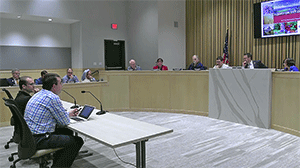
The Hermiston City Council voted Monday night to consider creating a third urban renewal district this year to pay for a new road connecting Highway 395 to N.E. Fourth Street.
City Planner Clint Spencer told the council that a new east-west street will relieve congestion in the busy north Highway 395 corridor between Theater Lane and Elm Avenue. That area, according to the Oregon Department of Transportation, is the busiest section of highway in all of Region 5, and the busiest intersection in the region is the Elm Avenue-Highway 395 intersection.
Spencer said the cost of the proposed street project is estimated at $4 million. To pay for it, he is proposing a new urban renewal district which would take the assessed value within an area and freezes that property tax at today’s value. As the tax increment and assessed value in that district increases over time, that increased revenue is used pay for improvements.

Spencer said the preliminary analysis indicates that tax revenue generated by a new urban renewal district would be in the range of $5 million to $6 million over the 20-year life of the district – more than enough to cover the cost of the project as well as the cost of purchasing the property where the street would be built. That revenue estimate could be higher, said Spencer, if the proposed street spurs new development in the area.
The area proposed for urban renewal has several potential high value vacant properties both on Highway 395 and on N.E. 4th Street. Spencer said there are also off-highway parcels and under-utilized sites within the area that provide opportunities for additional development or re-development.
The cost to form a new urban renewal district is about $40,000 which would pay for the necessary documentation as well as the cost of public hearings and informational meetings. The cost to purchase the land for the street development is estimated at $150,000, said Spencer.
Mayor Dave Drotzmann said he supports looking further into the proposal, but said urban renewal districts have long-term financial impacts.
“They take significant dollars out of our taxable assessment value base that we use in our budgeting process,” he said.
Spencer agreed, stating the downtown urban renewal district costs the city about 1.4 percent of revenue each year.
“And this is bigger in assessed value,” said Drotzmann. “That does impact the budget moving forward for the next 20 years. And so, we have to try to justify that investment and loss of revenue to the general fund.”
Spencer said the preferred funding option is an urban renewal district because the upfront costs are lower and offers bonding options with a longer repayment time.
Drotzmann acknowledged that the property may never be developed if the city doesn’t build a connecting street.
“We’ve got to balance both of those issues,” he said. “I’m supportive of moving forward, at least with the conversation.”
Spencer said it’s likely the new district won’t have to forfeit tax revenue from the district for the entire 20 years. For example, he expects to sunset the downtown urban renewal district earlier than its designated 20-year life due to the revenue generated from new development. Specifically, the Holiday Inn Express was built inside the district within two years of its formation. That hotel has an assessed value of $7 million.
“So, we’re already ahead of our revenue projections (for that district) based on that one development,” he said.
The council voted unanimously to continue looking into the costs and benefits of a new district.










